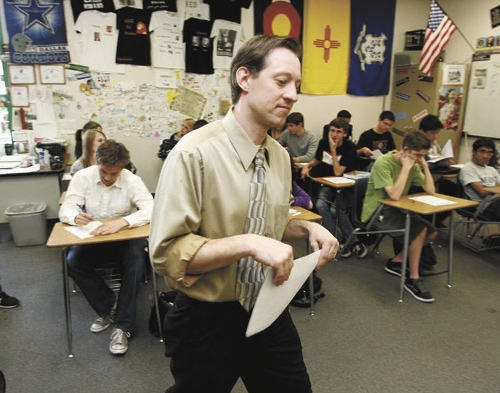As budgets shrink, Clark County school class sizes keep growing
Some teachers already call it the "big squeeze."
Others see the prospect of packing more students into Clark County School District classrooms as a state mandate to "Stack 'em deep, teach 'em cheap."
The number of students sitting in front of teachers at all grade levels is likely to increase next year, as district officials wrestle with how to improve student performance during a severe fiscal crisis.
It's a bad marriage of issues, said Clark County Education Association President Ruben Murillo.
He leads the union that bargains for the district's 18,000 teachers and nonadministrative licensed personnel.
"You can't cut your way to better student performance," Murillo said.
The debate over class size in public schools is being waged on three different fronts.
■ In Clark County, education leaders are relying on class-size increases across all grade levels to help remedy a 2011-12 budget shortfall that may exceed $400 million, courtesy of expected reductions in state support and declining local tax revenues.
Students in secondary grades will bear the brunt of the crunch. Officials expect to raise the average class size in grades 6-12 from 32 students to 34.
Murillo points out that many classes will exceed that average, especially in core subjects such as English and math, which all students must take. Teachers in those courses may well end up having classes that exceed 50, he said.
In addition, the district may lay off as more than 850 teachers, and fewer teachers means fewer course offerings and bigger classes in those that remain.
■ In Carson City, the issue is enmeshed with Gov. Brian Sandoval's proposed $2.4 billion K-12 budget for 2011-13, which represents an 11 percent drop from the $2.7 billion spent in 2009-2011, according to an analysis presented to the Legislature.
The Republican governor's proposal, opposed by Democrats who are the majority in both the Assembly and state Senate, is paired with a package of school reforms. One change would make class-size reduction in grades 1-3 optional instead of mandatory.
Under Assembly Bill 558, funding that would have been used for class-size reduction and other programs would instead be diverted into an education block grant program that would be available to county districts for special uses.
Clark County School District officials oppose that bill, said Joyce Haldeman, associate superintendent for government and community relations, because the funding and distribution formulas dilute the effectiveness of key district programs, including class-size reduction and full-day kindergarten.
It also would drastically reduce the state funding that will be available for class-size reduction, she said. For the current school year, the Legislature approved spending $144.35 million on class-size reduction.
Another bill, AB129 sponsored by Assemblyman Randy Kirner, R-Reno, proposes changes to class-size reduction law the district finds more palatable. It would repeal the statewide requirements for class-size reduction and give local school boards the authority to establish their own pupil-teacher ratios for elementary schools.
"The best decisions are made close to the issue," said Kirner, adding that a one-size-fits-all, statewide approach to class-size reduction is not the ideal.
AB129 doesn't take money away from the program, Kirner said. Instead, it tells local districts, "You're accountable, but you also have the power to make adjustments."
■ Nationally, the effectiveness of class-size reduction continues to be hotly debated by education researchers and competing policy groups.
In a report released by the Center for American Progress called "The False Promise of Class-Size Reduction," Matthew Chingos, a fellow with the Brown Center on Education Policy at the Brookings Institution, criticizes the lack of quality research into the impact of class-size reduction on student achievement.
He also questions whether the billions of dollars poured into class-size reduction efforts by states and the federal government in recent decades have yielded results worth the investment.
Large-scale class-size reduction policies "clearly fail any cost-benefit test, because they entail steep costs and produce benefits that are modest at best," Chingos wrote in the report.
"When school finances are limited (as they always are), the cost-benefit test any educational policy must pass is not 'Does this policy have any positive effect?' but rather 'Is this policy the most productive use of these educational dollars?' "
The report from the Center for American Progress, a progressive group based in Washington, D.C., was criticized almost immediately by Class Size Matters, a New York nonprofit organization that advocates for smaller classes.
The Class Size Matters group termed the report "highly flawed," especially in its criticisms of Florida's class-size reduction efforts.
"Lowering class size is only one of four K-12 reforms that, according to the Institute of Education Sciences, have been proven to work through rigorous evidence," according to a Class Size Matters rebuttal on its website.
Nevada's debate plays out in much the same way. The state's class-size reduction program, enacted by the 1989 Legislature, has come under fire from Republicans and conservative policy groups as an expensive and ineffective means of improving student performance.
By the end of fiscal year 2010-11, the state will have spent about $1.83 billion on class-size reduction since the effort began, according to the 2011 Nevada Education Data Book distributed to legislators.
The Nevada Policy Research Institute, a conservative think tank, has been outspoken in its criticism of class-size reduction.
"It's a great example of a policy that sounds good but is not effective in improving student achievement," said Andy Matthews, the institute's vice president of operations.
He also takes issue with how much has been spent on smaller classes in the Silver State.
A far better use for the funds is investing in programs that improve teacher quality, which is directly linked to higher student achievement, Matthews said.
State Sen. Mo Denis, D-Las Vegas, chairman of the Senate Education Committee, supports class-size reduction.
His wife is a kindergarten teacher at Ronnow Elementary School, near Pecos Road and Washington Avenue, and he said he has observed the difference class-size reduction makes. Larger classes lead to delays in identifying students who are falling behind and create student safety issues because adult supervision has been stretched too thin, he says.
"You can be the world's greatest teacher, but when you get 50 to 60 kids in a classroom how effective are you going to be?" Denis asked.
Because of Nevada's ongoing fiscal crisis, lawmakers in a 2010 special session authorized school districts to increase primary grade class sizes by no more than two pupils per teacher in each grade.
That allowed pupil-to-teacher ratios of up to 18:1 in grades 1 and 2, and up to 21:1 in grade 3 during the 2010-11 school year.
In Clark County, those ratios may climb even higher in 2011-12. Class-size increases linked to expected budget shortfalls include going from 18 students to 21 in grades 1 and 2; from 21 students to 24 in grade 3; and from 30 students to 33 in grades 4 and 5.
The only good news regarding class sizes in Clark County came at an April 14 School Board meeting when officials announced that the average class in grades 6-12 would grow by two students instead of three.
Chief Financial Officer Jeff Weiler said that the district has $19 million remaining from a two-year, $54 million federal economic stimulus Education Jobs grant. Of the available funds, $9 million will be used to hold down average secondary class sizes to 34 students.
But ramping up the size of classes that already are large is the wrong direction to take in public education, according to Joan Parks, a librarian at the Southwest Career and Technical Academy.
Parks was among hundreds of teachers and district staff who took part in a series of rallies earlier this month to support public education and oppose budget cuts.
Teaching shouldn't be an exercise in crowd control, she said. "It's the kids who are going to suffer."
Contact Assistant City Editor Lisa Kim Bach at lbach@reviewjournal.com or 702-383-0287.
Editor's note: Gov. Brian Sandoval's proposed budget promises major funding cuts for public schools and higher education, and Nevada's education leaders are scrambling to figure out how to get by with fewer employees and programs. During the next three weeks, a multipart Review-Journal series will take a closer look at those cuts and how education officials plan to deal with them.
AHEAD THIS WEEK:
TUESDAY -- With less money and fewer teaching positions, individual principals must decide which elective classes will be eliminated and which will survive.
WEDNESDAY -- The 50 percent cut in money for textbooks and school supplies will save some jobs but may leave some schools looking for donations.




























